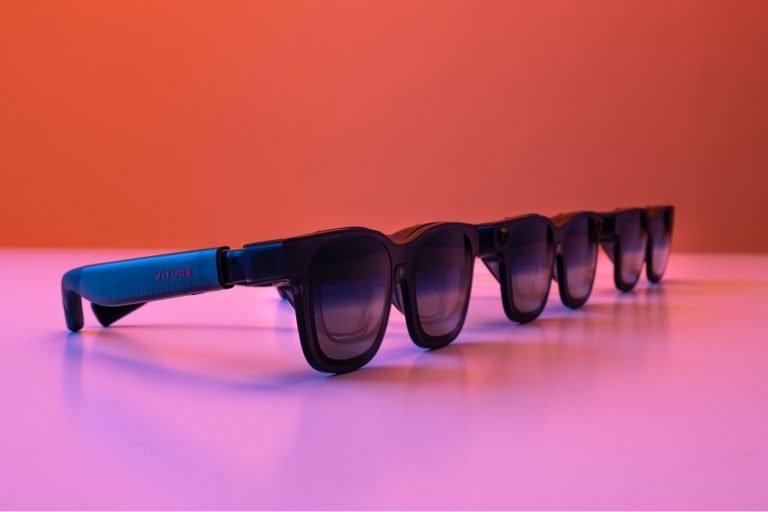
The tech enthusiast and professionals are paying Apple for SSD Storage upgrades. This upgrade proves to be very costly to the tech professionals. Apple is charging 1200$ for 4TB SSD Storage. The alternative of this is to develop and design your own DIY SSD which is Thunderbolt 5.
Yes, you can also buy OWC Envoy Ultra. This device is just 600$ but has some serious limitations.
The Thunderbolt 5 DIY SSD is very fast. It will be equipped with the best PCIe Express 4.0 SSD in the market and its price is just 300$. If this price seems expensive to you then you can also opt for 2TB which is just 170$. Apple is charging 600$ for this. This is the huge difference in price.
Enclosure Setup of DIY SSD
The enclosure comes with a zip up portable carrying case. When you open the case, you will find the Thunderbolt 5 cable and a small screwdriver.
Now, with the screwdriver open the device. The amazing part of the device is that it has a built-in cooling fan. Its function is to keep the device cool and emit the heat through exhaust vents. On the top it has two ports. One port is to connect with the MacBook and the other one is for the extra power. This feature is for the future when 8TB will come. This helps in giving more stability.
Now we have an SSD with the heat sink. With the help of a screwdriver remove its screw. When the heat sink is removed from the SSD, then install the SSD in the Trebleet device and fix its screws. After that place the thermal pad over the SSD to ensure good connection and close the device. Now the DIY 4TB Thunderbolt 5 SSD is completed.
Internal 1TB SSD Speed Test
Now the second step is to test the speed of the DIY 4TB Thunderbolt 5 SSD in the real world tasks.
The first step is to test the MacBook itself. If you are testing on M4 Max then keep in mind that it comes in 1TB SSD. This is a faster version but still you have to spend 1000$ on upgrading the 4TB. The internal read of M4 Max 1TB is 5163 and write is 6300.
OWC and DIY SSD Speed and Benefit
When the OWC is connected to M4 Max 1TB, the read speed of OWC is 4883 and the write speed is 5063. This speed is slower than the speed of the system itself. On the other hand, if we connect the DIY SSD to M4 Max 1TB then the read speed of the DIY SSD is 5780 and write speed is 6313. This speed is faster than the system itself. After this test and comparison it is obvious that OWC is slower than a DIY SSD.
Related links you may find interesting
300GB Real-world Write Speed Test
The next step is to test the SLC Cache in the real world transfer. First we will try the OWC drive. There is a folder that is 300GB which is 3TB. Now drag and drop the 300GB folder to the OWC empty drive and start the timer. You will clearly see that the read and write data both are about 5GB/sec. The SLC Cache means that there is only 50GB storage on this device while you are transferring large files. The rest of 4TB is slower which means the speed will slow down from 5GB/sec. This is a significant drawback because if you are buying a 4TB Drive then you have to make several folders that will exceed the 50GB. So we come to the result that OWC transfers 300GB files in 2 minutes.
Now connect the DIY SSD. Repeat the steps that were done while testing OWC Drive and start the timer. After a few seconds you will see that the read and write speed of the DIY SSD has reached 6GB/sec and will exceed over 50GB. This increase means that SLC Cache is higher in it. It transfers 300GB files in less than 1 minute.
Reverse SSD Read Speed Test
This is the last and final test to do is reverse SSD read speed test. For that you first have to delete the PC test folder from the M4 MacBook. Then drag and drop the PC test folder from the 4TB DIY SSD to the desktop and start the timer. When it finishes you will see that it took 1 minute and 4 seconds to do the reverse from the SSD to desktop.
Now it’s turn for OWC. Drag and drop the PC Test folder from OWC and start the timer. When the procedure finishes you will see it took 1 minute and 2 seconds to do the reverse from the SSD to desktop in OWC.
This shows OWC is slightly faster than 4TB DIY SSD in Reverse SSD Read Speed. OWC completed the procedure 2 seconds faster than the 4TB DIY SSD.
DIY SSD vs OWC SSD
The table of comparison below will sum up the debate and clear why DIY SSD is better than OWC SSD.
| Features | DIY SSD | OWC SSD |
| Read Speed | 5780 | 4883 |
| Write Speed | 6313 | 5063 |
| SLC Cache Read Speed | 6GB/sec | 5GB/sec |
| SLC Cache Write Speed | 6GB/sec | 5GB/sec |
| 300GB file transfer | Less than 1 minute | More than 2 minutes |
| Reverse SSD Read Speed | 1 minute 4 seconds | 1 minute 2 seconds |
This table of comparison clearly shows that the DIY SSD has great advantage over OWC SSD in every aspect.
Conclusion
We have built our own DIY SSD instead of buying from Apple for 1200$. The enclosure Trebleet of the DIY SSD cost just 200$ and PCIe 4.0 Express SSD cost just 300$. As it is said previously, if a PCIe 4.0 Express SSD seems to be expensive then you can also opt for 2TB as well which is just 170$. By this you can easily upgrade your SSD Storage without paying an expensive price to Apple.





